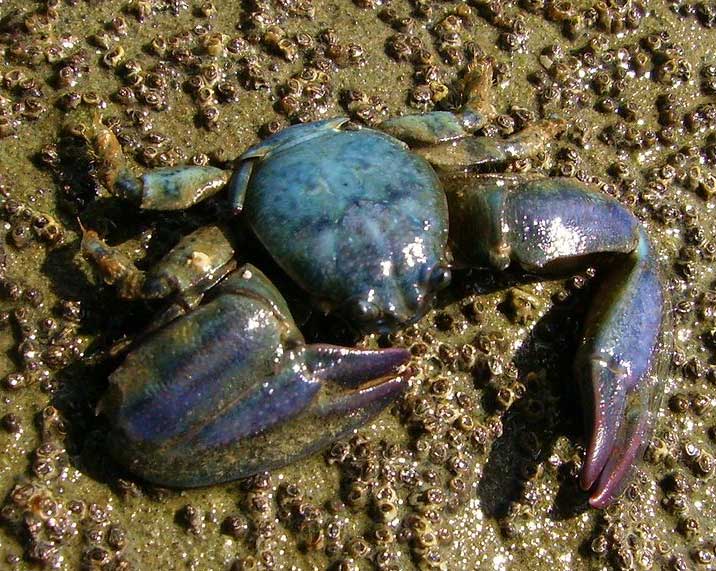
Petrolisthes elongatus
Superregnum: Eukaryota
Cladus: Unikonta
Cladus: Opisthokonta
Cladus: Holozoa
Regnum: Animalia
Subregnum: Eumetazoa
Cladus: Bilateria
Cladus: Nephrozoa
Cladus: Protostomia
Cladus: Ecdysozoa
Cladus: Panarthropoda
Phylum: Arthropoda
Cladus: Pancrustacea
Superclassis: Multicrustacea
Classis: Malacostraca
Subclassis: Eumalacostraca
Superordo: Eucarida
Ordo: Decapoda
Subordo: Pleocyemata
Infraordo: Anomura
Superfamilia: Galatheoidea
Familia: Porcellanidae
Genus: Petrolisthes
Species: Petrolisthes elongatus
Petrolisthes elongatus (H. Milne-Edwards, 1837)
Petrolisthes elongatus, known as the New Zealand half crab,[2] elongated porcelain crab, blue half crab, blue false crab or simply as the half crab or false crab,[3] is a species of porcelain crab native to New Zealand.
Description
The carapace is flattened with smooth side and rear margins, width is up to 18 mm (0.71 in),[2] and long whip-like antennae grow from the front corners, with the short rostrum extending beyond the large prominent eyes. The animal either filter feeds with long setae borne from the maxilliped palps, or scavenges by chopping up flesh with the second maxilliped and further shredding with the mandibles. The large chelipeds are generally smooth with no teeth or serrations, mainly used for territorial defense among males, who usually have one enlarged. Chelipeds and legs bear randomly located spines which can break off with wear, and these areas are dorsally coloured the same as the carapace, in black, blue, greenish or greyish, the ventral areas lighter. The last pair of legs are setose, reduced in size and carried folded under a large abdominal flap, which also allows the animal to swim backwards. Telson and uropods also setose.
Studies in New Zealand from the 1960s and 1970s showed a difference in breeding biology from north to south, with ovigerous females found all year round in Auckland, and only in the summer months around Kaikōura. Females are assumed to brood two or three times during their lifespan, producing 500 - 1000 eggs.[4]
Distribution & Habitat
P. elongatus is native to all areas of New Zealand but has also been introduced to Tasmania and Victoria, Australia.[3] In New Zealand it habits mussel beds, wharf pilings, estuaries, and the intertidal zone on rocky shores, where it is abundant beneath boulders and stones.[4]
References
Masayuki Osawa & Patsy A. McLaughlin (2010). "Annotated checklist of anomuran decapod crustaceans of the world (exclusive of the Kiwaoidea and families Chirostylidae and Galatheidae of the Galatheoidea) Part II – Porcellanidae" (PDF). The Raffles Bulletin of Zoology. Suppl. 23: 109–129. Archived from the original (PDF) on 2012-03-02.
"Crabs". Species Register. Marine Discovery Centre. Archived from the original on July 23, 2011. Retrieved April 29, 2012.
Keith Davey. "Petrolisthes elongatus (Family Porcellanidae)". SpeciesBank. Department of the Environment, Water, Heritage and the Arts. Retrieved April 29, 2012.
McLay, Colin L., “Brachyura and crab-like Anomura of New Zealand”, University of Auckland, Leigh Marine Laboratory, 1988
Retrieved from "http://en.wikipedia.org/"
All text is available under the terms of the GNU Free Documentation License

